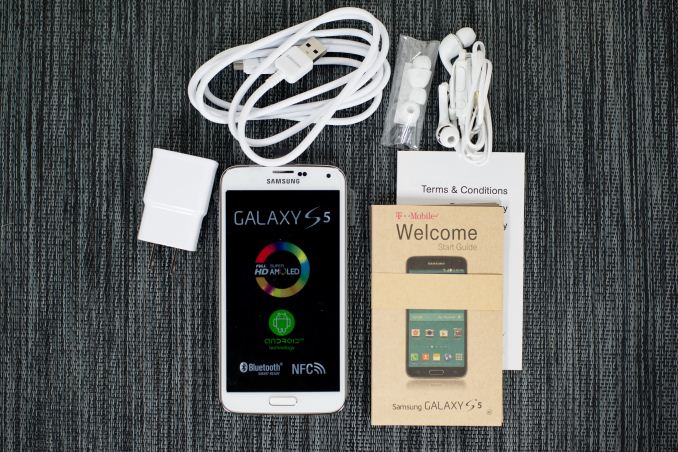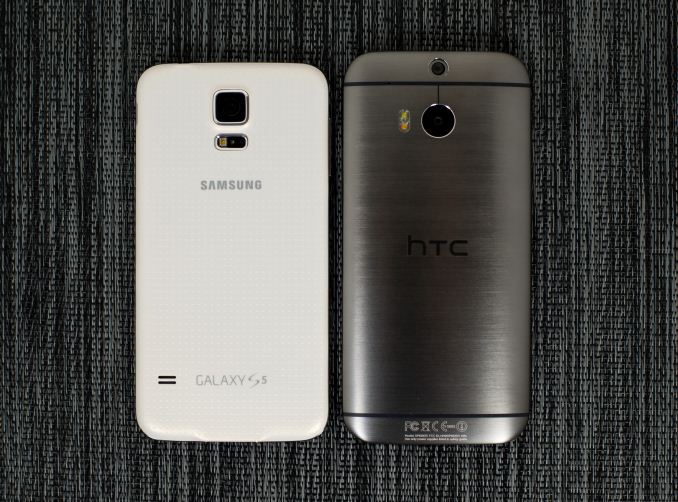Samsung Galaxy S 5 Review
by Anand Lal Shimpi & Joshua Ho on April 8, 2014 12:00 AM EST- Posted in
- Smartphones
- Samsung
- Mobile
- Galaxy S 5
Final Words
The Galaxy S 5 is a healthy update to the series. With the Galaxy Note 3's release last year we saw a device that ultimately became the new flagship from Samsung. The GS5 takes the crown back for those users who want a more reasonably sized device.
The GS5 sees upgrades across the board compared to its predecessor. The underlying silicon is both faster and more power efficient. The battery is larger, and battery life has improved dramatically thanks to silicon and display upgrades. Much like the gains we saw with HTC's M7 to M8 transition, anyone who is on a Snapdragon 600 based device today is going to be incredibly happy upgrading to a Snapdragon 801 platform like the GS5.
Connectivity sees a boost with the addition of Qualcomm's envelope tracker and support for carrier aggregation on LTE. The inclusion of 2x2 MIMO 802.11ac brings WiFi performance to a new level with the GS5.
The move to Samsung's own 16MP rear facing camera sensor brings about an increase in spatial resolution, and some improvements in low light performance compared to the Galaxy S 4. I'm not totally sold on the GS5's image processing but the overall camera experience is pretty solid. I would still like to see Samsung move to a slightly lower resolution sensor with larger pixels to provide a more balanced solution. As of now the GS5 is a solid shooter outdoors and with decent light, but indoors and in low light solutions it struggles.
NAND performance is about the only downside to the GS5's hardware upgrade, mainly in that it seems to ignore random read/write performance in favor of sequential gains. Anyone who has followed our SSD coverage at AnandTech should know the issues with this approach.
Display is also dramatically improved from the Galaxy S4. Samsung's AMOLED panels have finally caught up with LCD in most of the key metrics while retaining the key advantages of AMOLED such as infinite contrast and higher power efficiency at lower average picture level.
It's not all hardware upgrades that makes the GS5 what it is. Samsung did an excellent job of cleaning up its UI from the crowded mess that we saw in GS4 to something much more polished. It's not perfect, but a huge step in the right direction. While the GS4 felt more like feature creep for use in marketing materials, the GS5's software is far better executed.
There are even some nifty additions that can come in handy. Ultra low power saving mode is one in particular that seems to have a measurable impact on battery life if you're willing to give up some performance.
Overall the Galaxy S 5 is a solid replacement to the GS4 (and definitely to any previous Samsung device). I find that pretty much all the flagships offer some set of tradeoffs that prevent any one from being the perfect device (iPhone's screen size, GS5's materials, M8's camera). It's unfortunate because I'd really like to crown a single device the king of them all, but instead we're faced with a handful of differing optimization points. Samsung got it almost perfect with the GS5. With a metal body, a rear facing camera with larger pixels (perhaps with some tweaks to camera output processing), a better NAND controller, and stereo front facing speakers, the GS5 would probably be perfect.












296 Comments
View All Comments
stacey94 - Tuesday, April 8, 2014 - link
The home screen edit mode is just like that on the Google Now Launcher for Nexus devices. I don't think that's Sense-specific.JoshHo - Tuesday, April 8, 2014 - link
The stock Nexus 5 in front of me doesn't have any helicopter view if I try to pinch inwards, how did you get the home screen edit mode to appear?stacey94 - Tuesday, April 8, 2014 - link
Press and hold on an empty part of the home screen. The pinch effect isn't there.JoshHo - Tuesday, April 8, 2014 - link
Ah, I see. Was this in previous versions of the AOSP launcher? I know that Sense had this edit mode as far back as Sense 4.0, and I don't recall anything else at the time that had the same UI for home screen editing.stacey94 - Tuesday, April 8, 2014 - link
No, I don't believe so. I don't think there was an edit mode at all, aside from the widget drawer.I have to ask, though. How were you adding widgets to the Nexus 5's home screen without knowing about that mode? (Or is it not a device you normally use?) I don't think there's any other way to do it, since the widget drawer is no longer conjoined to the app drawer.
And yes, I think that UI first showed up in Sense 4. Google definitely borrowed it, but didn't implement it as well. You can't delete entire home screens with at once, for example.
JoshHo - Tuesday, April 8, 2014 - link
I didn't have any issues setting up widgets/homescreens on the Nexus 5, although it seems that I didn't remember exactly how I did.It may be that Samsung is simply following Google's lead in this respect.
rogueninja - Tuesday, April 8, 2014 - link
TouchWiz is still so ugly, and Apple's measley dualcores are still kicking every Android's terribly optimized glutes.Brian Z - Tuesday, April 8, 2014 - link
If you think the dual core in Apple devices is measly, then you really need to read the site more.pppp6071 - Tuesday, April 8, 2014 - link
Guys apple uses two BIG cores not small ones in quad or octa core andrioid's...compare the chip area and u will get to know. Its always the debate between big cores or small multiple cores. There is no magic wand with apple.darkich - Tuesday, April 8, 2014 - link
Exactly.Two different concepts.
The alone fact that those "measly" cores have the same, maybe even slightly higher power draw as the four Krait 400 cores, shows that they are entirely different beasts